Japan was again the top-performing whisky region on the secondary market. Prices for Port Ellen stalled while the Macallan price rally stopped abruptly. Here is the second part of our round-up for the year 2018.
In the first part of our 2018 Annual Report, we discovered that while the market continues to grow, the market’s composition is constantly changing. Releases without age statements gained market shares, but it is primarily the oldest whiskies which experienced continuous price increases. In this second part, we want to continue where we left off, by looking at the market composition with respect to the vintage.
The Market and Vintage
For this analysis, we split the whiskies in our database into seven different clusters according to their year of distillation. These clusters represent the decades starting from the 1970s through the years between 2000 and 2010, with everything before 1970 and everything after 2010 assembled into two groups. Additionally, there are non-vintage releases. First, we visualize the market shares with respect to the sheer number of traded bottles.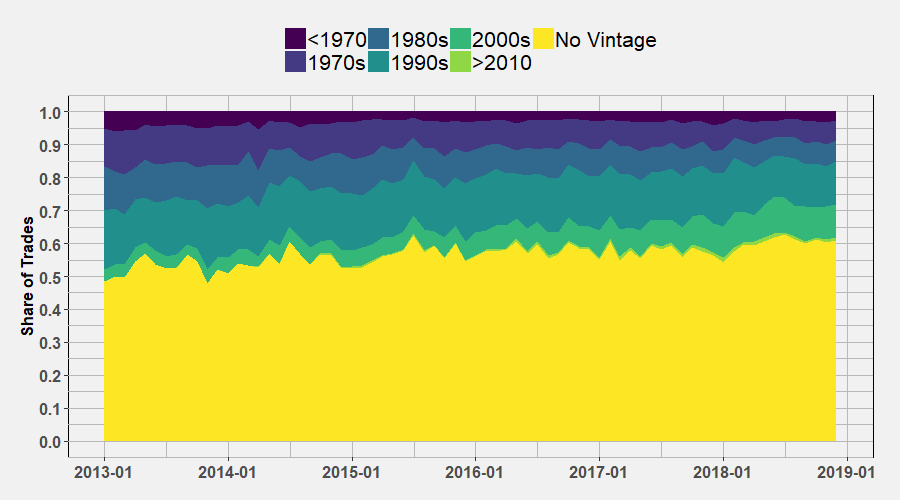 In early 2013, about half of all traded bottles did not have any vintage information. Over the last six years, this changed. In the second half of 2018, this share stabilized at around 60% and above. So over the last couple of years, the market share of “no vintage” releases increased by approximately ten percentage points, which perfectly aligns with the market increase of NAS bottlings which we saw in the first part of our report. Naturally, the younger vintages of the current millennium increased too as more and more of these whiskies reached the “optimal” maturation time. Also quite intuitively is the fact that the relative share of the very old vintages decreases over time. By the end of 2018, only about 7% of all bottles traded were distilled in the 1980s. Six years ago, it was 10% and more.
In early 2013, about half of all traded bottles did not have any vintage information. Over the last six years, this changed. In the second half of 2018, this share stabilized at around 60% and above. So over the last couple of years, the market share of “no vintage” releases increased by approximately ten percentage points, which perfectly aligns with the market increase of NAS bottlings which we saw in the first part of our report. Naturally, the younger vintages of the current millennium increased too as more and more of these whiskies reached the “optimal” maturation time. Also quite intuitively is the fact that the relative share of the very old vintages decreases over time. By the end of 2018, only about 7% of all bottles traded were distilled in the 1980s. Six years ago, it was 10% and more. This second chart measures the market share by the prices paid for these whiskies. Obviously, the picture changes as the old vintages tend to be expensive. Nowadays, the pre-1980 vintages account for roughly 10% of all bottles traded but at the same time for 30% of the money spent on auctions. We also see that for the pre-1970 vintages, this figure increased from 10% in 2015 to 15% at the end of 2018.
This second chart measures the market share by the prices paid for these whiskies. Obviously, the picture changes as the old vintages tend to be expensive. Nowadays, the pre-1980 vintages account for roughly 10% of all bottles traded but at the same time for 30% of the money spent on auctions. We also see that for the pre-1970 vintages, this figure increased from 10% in 2015 to 15% at the end of 2018.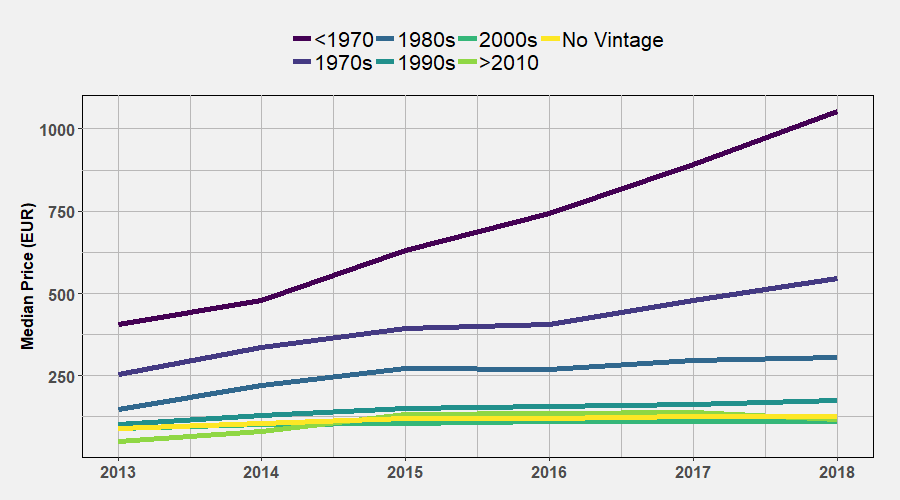 And finally, we also take a look at the median prices paid for these vintage clusters. And no surprise here, the oldest vintages experienced the highest price increases. In 2013 half of the pre-1970 vintages traded for less than 400 Euros. By 2018 this median price has more than doubled. 50% of all pre-1970s vintages now trade for more than 1.000 Euros. The other decades follow accordingly.
And finally, we also take a look at the median prices paid for these vintage clusters. And no surprise here, the oldest vintages experienced the highest price increases. In 2013 half of the pre-1970 vintages traded for less than 400 Euros. By 2018 this median price has more than doubled. 50% of all pre-1970s vintages now trade for more than 1.000 Euros. The other decades follow accordingly.
The Market Indices
Our chosen method for summarizing the secondary whisky market is our major market indices. You will find a detailed explanation of these indices in our descriptions. The Whiskystats Whisky Index (WWI) summarizes the change in the value of the 500 most traded whiskies each month. In 2018, the WWI was off to a great start gaining around 6% within a single round of auctions. What followed was a two-month setback from which the market recovered quickly as the WWI gained more than 14% from April to October 2018. In the last quarter of the year, prices consolidated again, with our major market index finishing with a 7,8% annual return.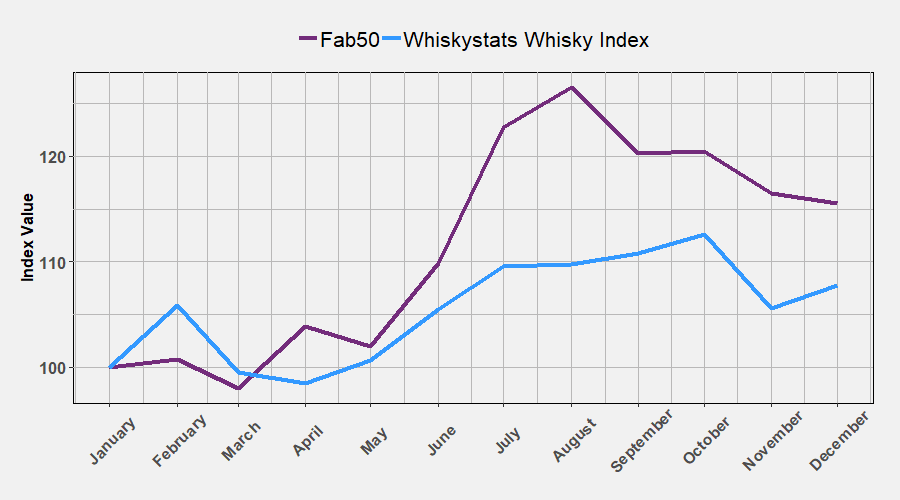 The Whiskystats Fabulous Fifty (Fab50) are a collection of 50 iconic releases that we begin to track in early 2013. During 2018 our Fab50 collection experienced a massive increase in value, climbing 26% from January to August 2018. In the closing months of 2018, prices decreased again. Nevertheless, our Fab50 collection closes the year with a 16% annual return.
The Whiskystats Fabulous Fifty (Fab50) are a collection of 50 iconic releases that we begin to track in early 2013. During 2018 our Fab50 collection experienced a massive increase in value, climbing 26% from January to August 2018. In the closing months of 2018, prices decreased again. Nevertheless, our Fab50 collection closes the year with a 16% annual return.
The Market Regions
The overall market movements described above can now be broken down into the major whisky regions. Similarly to the indices above, we scale our region indices to the value of 100 in January 2018 to better compare their movement during the year. The prices for Japanese whisky gained momentum again as our Japan index climbed by 35%. We also see that Islay bottlings were the primary cause of the February 2018 hiccup in the above displayed WWI.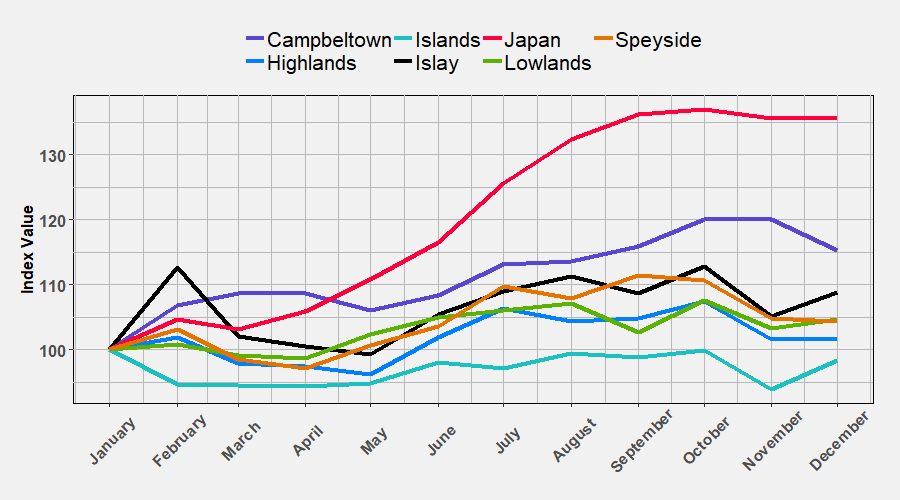 The second-best performing whisky region of 2018 is Campbeltown. Until October 2018, the most traded Campbeltown releases gained 20% in value. All other region indices closed the year with 2% to 9% annual performance except the Islands. The most-traded Island releases even lost slightly in value during 2018. We also see that the November round of auctions brought decreasing index values for almost all regions. So the drop we saw for the WWI was not a region-specific but a general one.
The second-best performing whisky region of 2018 is Campbeltown. Until October 2018, the most traded Campbeltown releases gained 20% in value. All other region indices closed the year with 2% to 9% annual performance except the Islands. The most-traded Island releases even lost slightly in value during 2018. We also see that the November round of auctions brought decreasing index values for almost all regions. So the drop we saw for the WWI was not a region-specific but a general one.
The Market Distilleries
We now turn our attention to the distillery indices and drill deeper by focusing on the top distilleries of our distillery ranking. Again the respective indices were scaled to 100 in January 2018 to better compare movements. Here three distilleries stand apart, with their indices gaining more than 30% within a single year. These are Yamazaki, Rosebank and Karuizawa. Together with the strong performance of Hanyu, this explains the movements of the Japan region as a whole.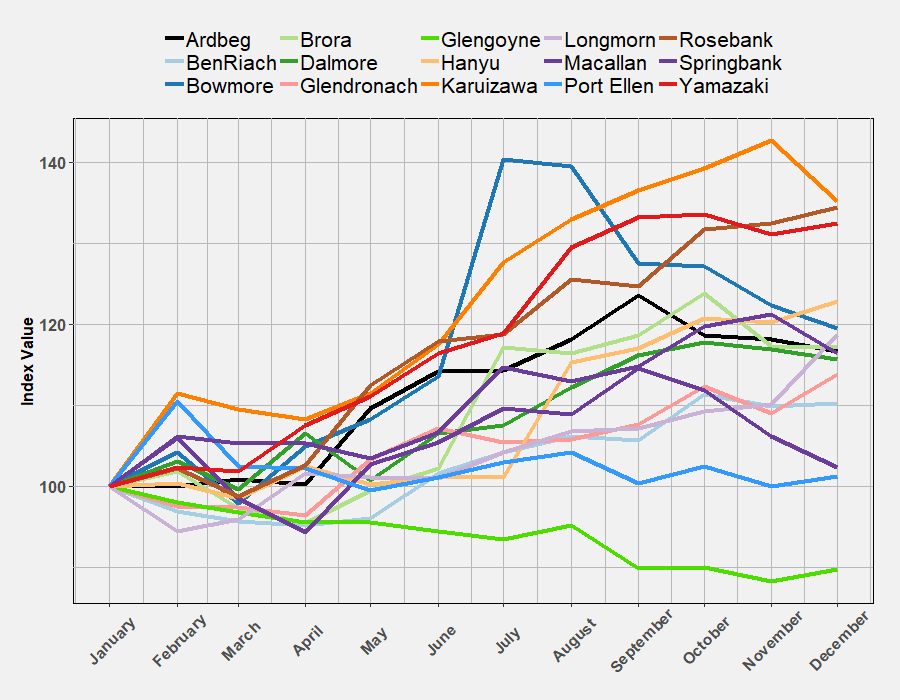 Rosebank is the best performing scotch distillery of 2018. Longmorn, whose index gained almost 20%, assumes second place. The Bowmore index had a massive jump in July but lost during the remainder of the year. At the bottom, we find Glengoyne losing almost 10%. Also quite interesting is our Port Ellen index, which did not move much. It seems like prices for Port Ellen have levelled. The chart below summarizes the index movements from January 2018 to January 2019, and we have added the ranking (and change in rank) accordingly.
Rosebank is the best performing scotch distillery of 2018. Longmorn, whose index gained almost 20%, assumes second place. The Bowmore index had a massive jump in July but lost during the remainder of the year. At the bottom, we find Glengoyne losing almost 10%. Also quite interesting is our Port Ellen index, which did not move much. It seems like prices for Port Ellen have levelled. The chart below summarizes the index movements from January 2018 to January 2019, and we have added the ranking (and change in rank) accordingly.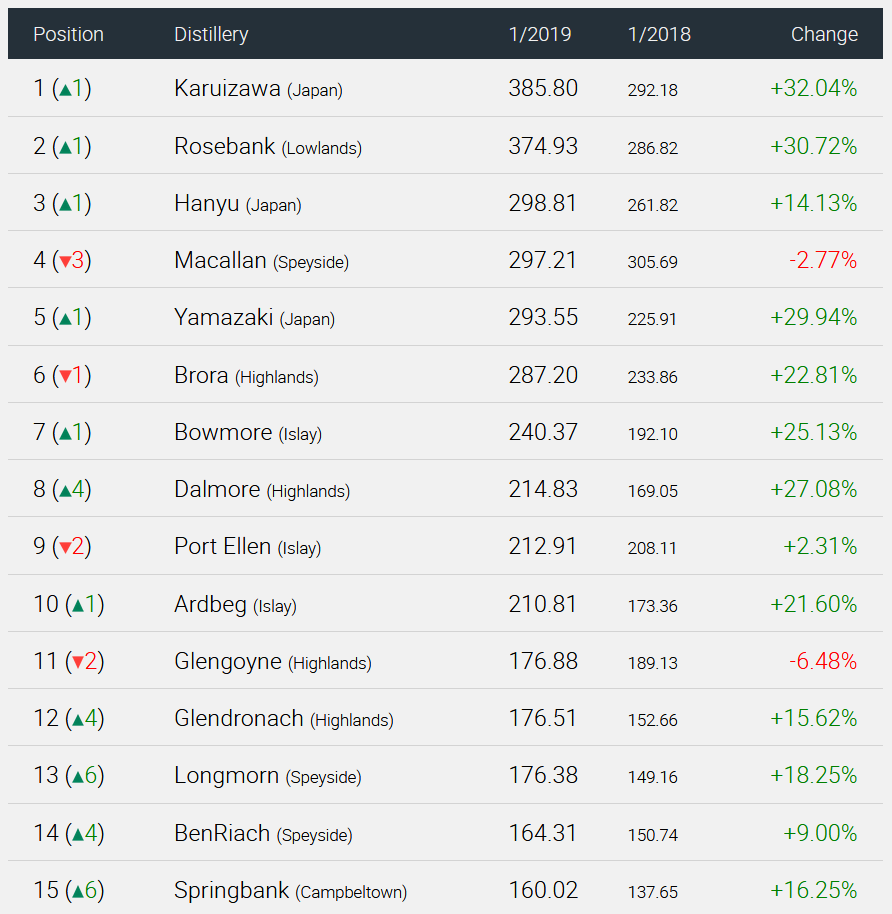
So Macallan started 2018 as the prime distillery on the secondary whisky market. In 2018 it lost this status as Karuizawa, Rosebank, and Hanyu took over. We observed solid performances among the top ten distilleries, often beyond 20%. However, along with Macallan, Port Ellen did not follow this trend. The most-traded Port Ellens roughly gained 2% in 2018. Springbank also had a solid year, gaining 16% and entering the top fifteen of our ranking.
The secondary whisky market never sleeps as new price observations drip in every month. The early auctions of 2019 saw some of the above observations changing already. For example, the Macallan index soared by almost 7% in February 2019, while Port Ellen continues to lose ground. And then Rosebank even overtook Karuizawa to top our ranking. To stay informed, make sure to continue following our monthly price updates.
Disclaimer: the whisky market insights presented in this article are based on the Whiskystats database at the time of publication. Whiskystats is constantly adding new data, and therefore some charts and figures may not match after initial publication.
